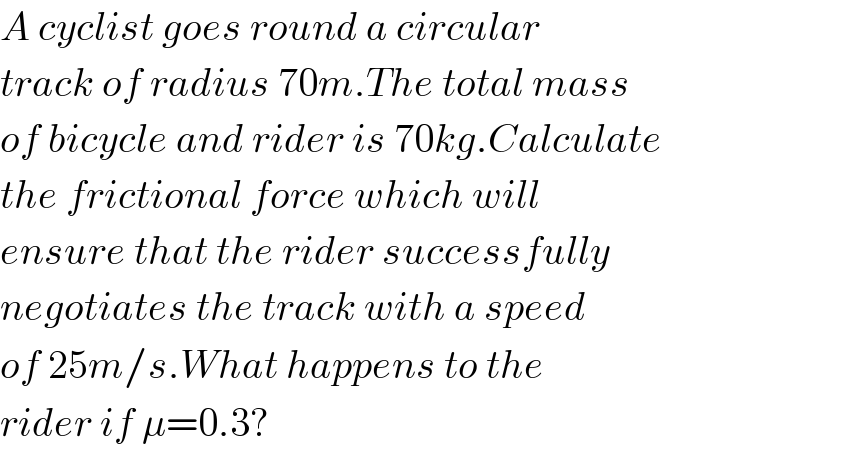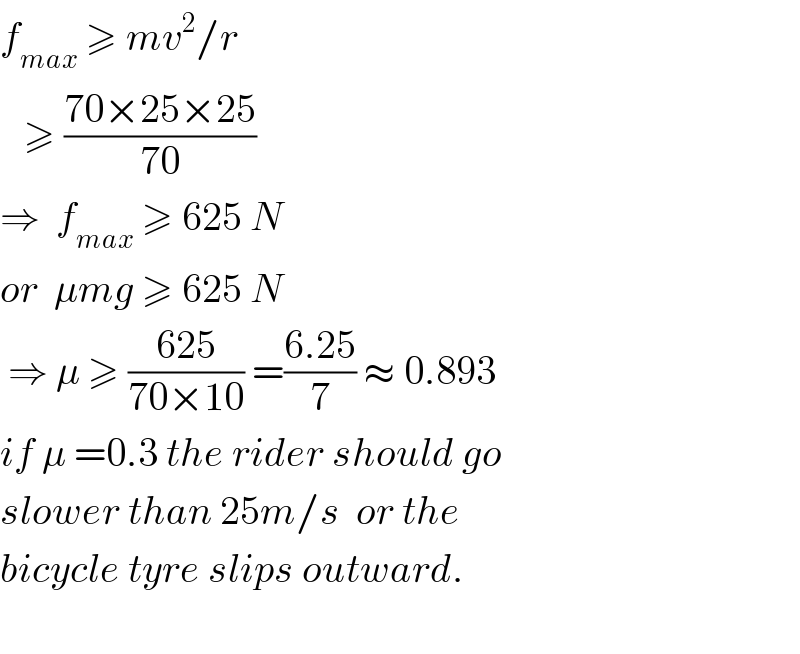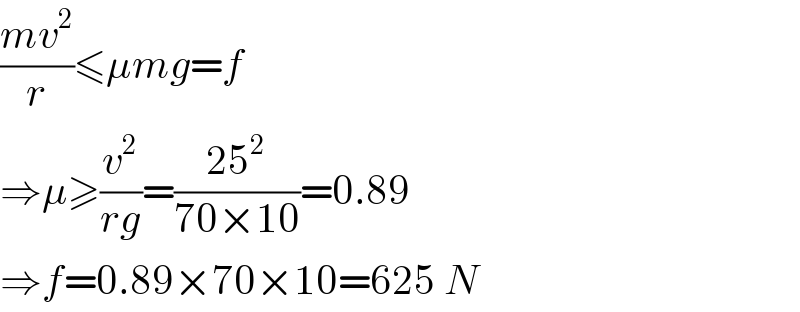
Question Number 24175 by NECx last updated on 13/Nov/17

$${A}\:{cyclist}\:{goes}\:{round}\:{a}\:{circular} \\ $$$${track}\:{of}\:{radius}\:\mathrm{70}{m}.{The}\:{total}\:{mass} \\ $$$${of}\:{bicycle}\:{and}\:{rider}\:{is}\:\mathrm{70}{kg}.{Calculate} \\ $$$${the}\:{frictional}\:{force}\:{which}\:{will} \\ $$$${ensure}\:{that}\:{the}\:{rider}\:{successfully} \\ $$$${negotiates}\:{the}\:{track}\:{with}\:{a}\:{speed} \\ $$$${of}\:\mathrm{25}{m}/{s}.{What}\:{happens}\:{to}\:{the} \\ $$$${rider}\:{if}\:\mu=\mathrm{0}.\mathrm{3}? \\ $$
Commented by NECx last updated on 13/Nov/17

$${please}\:{help} \\ $$
Commented by ajfour last updated on 14/Nov/17

Commented by ajfour last updated on 14/Nov/17

$${f}_{{max}} \:\geqslant\:{mv}^{\mathrm{2}} /{r} \\ $$$$\:\:\:\geqslant\:\frac{\mathrm{70}×\mathrm{25}×\mathrm{25}}{\mathrm{70}}\: \\ $$$$\Rightarrow\:\:{f}_{{max}} \:\geqslant\:\mathrm{625}\:{N} \\ $$$${or}\:\:\mu{mg}\:\geqslant\:\mathrm{625}\:{N} \\ $$$$\:\Rightarrow\:\mu\:\geqslant\:\frac{\mathrm{625}}{\mathrm{70}×\mathrm{10}}\:=\frac{\mathrm{6}.\mathrm{25}}{\mathrm{7}}\:\approx\:\mathrm{0}.\mathrm{893} \\ $$$${if}\:\mu\:=\mathrm{0}.\mathrm{3}\:{the}\:{rider}\:{should}\:{go} \\ $$$${slower}\:{than}\:\mathrm{25}{m}/{s}\:\:{or}\:{the} \\ $$$${bicycle}\:{tyre}\:{slips}\:{outward}. \\ $$$$ \\ $$
Commented by NECx last updated on 14/Nov/17

$${thank}\:{you}\:{sir}.\:{You}\:{cleared}\:{my} \\ $$$${doubt}. \\ $$$$ \\ $$
Commented by NECx last updated on 14/Nov/17

$${thank}\:{you}\:{sir}.\:{You}\:{cleared}\:{my} \\ $$$${doubt}. \\ $$$$ \\ $$
Commented by NECx last updated on 14/Nov/17

$${thank}\:{you}\:{sir}.\:{You}\:{cleared}\:{my} \\ $$$${doubt}. \\ $$$$ \\ $$
Answered by mrW1 last updated on 14/Nov/17

$$\frac{{mv}^{\mathrm{2}} }{{r}}\leqslant\mu{mg}={f} \\ $$$$\Rightarrow\mu\geqslant\frac{{v}^{\mathrm{2}} }{{rg}}=\frac{\mathrm{25}^{\mathrm{2}} }{\mathrm{70}×\mathrm{10}}=\mathrm{0}.\mathrm{89} \\ $$$$\Rightarrow{f}=\mathrm{0}.\mathrm{89}×\mathrm{70}×\mathrm{10}=\mathrm{625}\:{N} \\ $$
Commented by NECx last updated on 15/Nov/17

$${Thank}\:{you}\:{sir}. \\ $$$$ \\ $$
